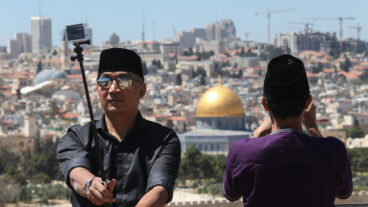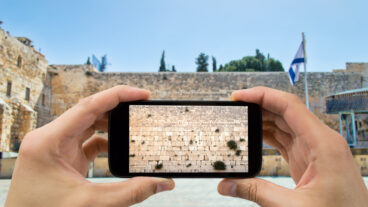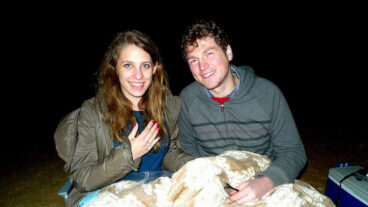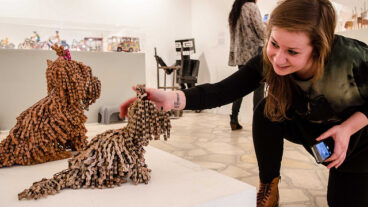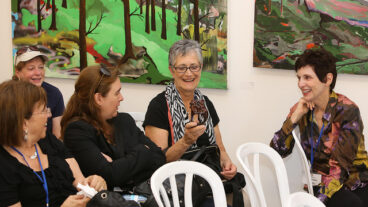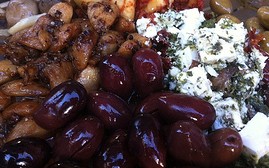The only U.S. exhibition of the rare and priceless Dead Sea Scrolls in 2003 was unveiled at the Public Museum of Grand Rapids in Michigan. This story, illustrating how Israel shares the treasures of antiquities with the world, was placed on the Associated Press wire and the wire story was published in 116 local and national media outlets across America, reaching over 5 million readers.
Here is the AP story that appeared on February 8, 2003.
DEAD SEA SCROLLS EXHIBIT PREPARES TO OPEN
By James Prichard
Grand Rapids – The Public Museum of Grand Rapids is billing its new show as “an exhibition of biblical proportions” and for good reason.
Portions of the Dead Sea Scrolls, a priceless collection of biblical manuscripts about 2,000 years old, will be displayed at the organization’s Van Andel Museum Center from Feb. 16 through June 1.
The show will provide Westerners with a rare glimpse of the sacred writings, which contain sections of Exodus, Psalms and other books of the Bible. Fragments of a dozen different scrolls, plus 80 artifacts from the ancient community where they were discovered, will be displayed.
The last time the scrolls were exhibited in the United States was in 2000 at the Field Museum in Chicago. That show drew about 300,000 visitors in three months.
Timothy Chester, director of the Grand Rapids museum, says he expects the upcoming exhibition to attract about 225,000 visitors during its 3½-month run. That would easily make it the most successful temporary exhibit in the city-owned museum’s 149-year history.
“When you start organizing an exhibition that draws as many as 50,000 people, it’s having an immense (local) economic impact,” he says. “When you draw 200,000 people, all of a sudden then this venue is starting to help cement a community and give it a reputation as a place that is sophisticated both in terms of its practices but also in what it can offer the public.”
So far, about 14,000 tickets have been sold. They cost $14 for adults, $13 for seniors and $10.50 for visitors age 17 and under.
When planning started a little over two years ago, organizations in two other, much larger cities were also going to host the exhibition. But Salt Lake City and then Houston bowed out, citing security and financial concerns.
Chester says the Grand Rapids museum decided to go on with the show, spending $1.2 million on it, $800,000 more than expected.
Many activities are planned around the exhibit, including an April 1 lecture by Emanuel Tov, editor-in-chief of the official Dead Sea Scrolls publication project. Tov, a Bible professor at Hebrew University in Jerusalem, is widely considered to be the world’s foremost authority on the scrolls.
The Dead Sea Scrolls are comprised of the remains of approximately 900 separate documents, represented by about 100,000 fragments. The texts were most commonly made from animal skins, but some were made from papyrus and one from copper. Most were written in the regional languages of Hebrew and Aramaic, with a few in Greek.
Most religious scholars believe that the scrolls were created by a sect of monastic Jews called the Essenes, who left mainstream Judaism to live a communal life in the desert near the northwestern coast of the Dead Sea. When the Romans invaded their community, Qumran, around A.D. 68, the Essenes hid the manuscripts in nearby caves. The scroll fragments were discovered between 1947 and 1956 in 11 caves along the shore of the Dead Sea. The arid region is 13 miles east of Jerusalem and 1,300 feet below sea level.
Great care will be taken with the scroll pieces so they will not be damaged while exposed for viewing, says Pete Daly, a spokesman for the Grand Rapids museum. The fragments will be displayed in climate-controlled showcases that the museum built specially for them, and no flash photography will be permitted.
In a sign of the times, the museum also is increasing its security presence for the event, and visitors will be required to pass through metal detectors.
Though Grand Rapid’s size and upper Midwestern location might seem to make it an unlikely candidate for a Dead Sea Scrolls exhibition, the city had other factors going for it.
The Van Andel Museum Center, the main headquarters of the Public Museum of Grand Rapids, is a large, attractive, state-of-the-art facility. Opened in 1994, it was designed with significant, international shows in mind.
“For the museum, this (exhibit) is really a fulfillment of a promise that was made when we designed and built this new facility, which we spent $42 million on,” says director Chester.
Another factor in Grand Rapids’ favor was that some of the area’s first European settlers in the mid-19th century were deeply religious Dutch reformists whose two Protestant churches are still among the region’s three biggest denominations.
According to studies by the American Religion Data Archive, the Grand Rapids-Muskegon-Holland area in 2000 had more than 173,000 members of the Roman Catholic church, over 92,000 members of the Grand Rapids-based Christian Reformed Church in North America and more than 63,000 members of the Reformed Church in America.
The metro area had four synagogues and an estimated Jewish population of 2,010, ARDA reported.
Two representatives of the Israel Antiquities Authority, which owns the Dead Sea Scrolls, visited the Grand Rapids museum before approving the exhibit. They went away impressed with the building and “also with the religious emphasis that we have here in western Michigan, both Jewish and Christian,” says Bastiaan Van Elderen, a retired Calvin Theological Seminary professor and scrolls scholar who helped bring the exhibit to Grand Rapids.
“The Israelis wanted to be sure we were large enough and professional enough and had the technical ability to protect the scroll fragments and artifacts,” says museum spokesman Daly.
While the exhibit will be a landmark event for the city and the museum, it will also be important to the Israel Antiquities Authority, Chester says. The organization knows that most people will never visit Jerusalem, where the fragments are permanently kept at the Shrine of the Book.
“They realized there was value in getting this material out and allowing people to experience it, because everywhere the scrolls have been, they’ve met with great public interest,” he says.
(Copyright 2003 by The Associated Press. All Rights Reserved.)




